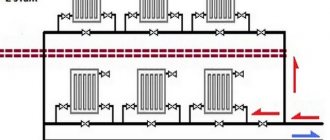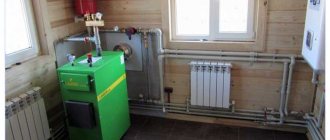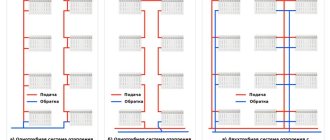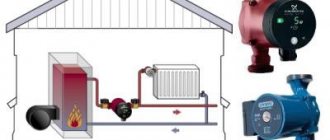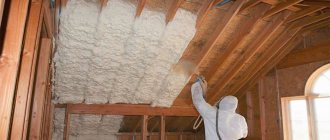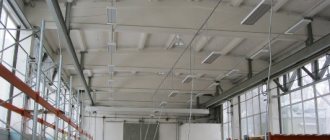What does the heating system consist of?
The main structural details of the heating system of a private house:
- radiator set;
- coolant – most often water, but it can be a gaseous medium or non-freezing liquid, depending on the type of boiler;
- boiler - electric, gas, solid fuel, diesel or kerosene;
- heat pipe.
The system has a closed principle of operation, that is, first the coolant is heated by the boiler, sent through a pipeline to the radiators, and then, cooled down, returned to the heat source. A set of heating devices together with a heat pipe is called a heating circuit.
The listed elements are enough to create a simple heating project for a two-story house. However, to increase the efficiency of autonomous heating, a few more details are added to the diagram:
- filter – needed to protect the boiler from clogging;
- pump – for forced circulation of coolant through pipes;
- safety devices (pressure relief valve, air vent, pressure gauge) - required in systems with forced circulation;
- expansion tank - collects excess coolant when it overheats and expands in volume.
This creates a heating scheme for a two-story house with forced circulation.
The heating system consists of many interconnected elements Source opechi.ru
Installation technology for gravity heating systems
- Determining the boiler model and its location is the most important thing in the entire gravity heating system. This unit heats the coolant.
- Now, according to the gravity heating system, we determine the location of the pipeline using the diagram. There are 2 types of pipe laying - single and double.
- We choose radiators that will be located in the rooms, basement and attic (if necessary).
- Do not forget that it is also necessary to select an expansion tank.
During the installation of the pipeline, it should be remembered that the line being created must have a certain slope. This indicator is calculated in such a way that each meter of pipe tilts by 0.005 m. The tilt angle should be directed towards the heating tank.
Why is it necessary to implement this requirement?
- The presence of a pipe slope allows the coolant to move faster.
- During operation of this type of heating system, air bubbles appear. In order to remove them from the pipes, the pipeline is tilted. In this case, during the process of heating water, the coolant expands. And the bubbles end up in the open expansion tank for heating. This is where they are released into the atmosphere.
Basic system requirements
There are a number of important requirements that must be taken into account when designing a heating system.
- In general, the heating design of a two-story house must correspond to the architectural design of the building. The placement of the boiler requires certain structural and design conditions of the room in which it will be located. The installation locations of radiators, as well as the pipeline routes, should not violate the architectural rules for the arrangement of residential and technical premises. All this means that a qualified designer must draw up a plan for the heating system, based on the finished architectural design of the house.
- During operation, the system must provide all internal and external surfaces with the temperature required by building codes and regulations (SNiPs).
- The system must be quite economical to operate. If heating your home requires too much energy consumption, you should contact a specialist: perhaps some parts or components can be unified.
- The pipeline should have a minimum of bends and turns. If during its installation you need a large number of fasteners in different sizes, it means that the heating circuit is poorly designed.
It is always necessary to draw up and evaluate a preliminary scheme Source tapiart.ru
- During use, the system must be reliable, safe, convenient and silent. A good system allows home owners to easily control heating appliances and, if necessary, easily repair them.
- The aesthetic side is also important. Radiators and pipes connected to them must have a neat, attractive appearance. The less noticeable the heating elements are, the better.
Single-circuit system
With a single-circuit system, all heating components are installed in a sequential order, and the heating boiler is located at the bottom. For a two-story house, the design of a single-pipe heating system is quite simple, which is why it is very popular among cottage owners.
Passing through the boiler, the water heats up and enters the first radiator, where it gives off some heat to the room, then to the second, third, etc. After that, she comes back and the cycle begins again. It turns out to be a large ring covering the entire house. The least amount of heat goes to the last radiator in the chain. This shortcoming can be compensated for by consistently increasing the number of sections of heating batteries - the last one will be the largest. As a result, the heat transfer area becomes larger, and accordingly, the temperature in the room is equalized.
In this video you will learn more about Leningrad:
Operating principle and advantages
The system involves natural circulation of water, that is, without the use of a pump. The principle of its operation lies in the different densities of hot and cold coolant and the presence of an expansion tank installed at the highest point of the hot water riser. It absorbs excess expanding coolant, preventing an increase in pressure in the pipes and their rupture.
The heated water flows self-propelled to the second floor, enters the radiators and moves along the risers. Giving off heat, it cools and returns to the boiler. To remove air locks on radiators, special Mayevsky taps are installed. If we compare two-pipe and single-pipe heating, the second has its advantages:
- Independence from the power grid. If there is a power outage, the system will not be affected in any way, and the house will be warm.
- The entire internal perimeter of the house is one closed ring of pipes, which does not depend on the layout of the premises.
- If necessary, you can easily connect a pump, additional radiators and heated towel rails, as well as pipes, for example, for heated floors.
- The main pipe can be hidden in the wall or floor.
- The water temperature can be easily adjusted by decreasing or increasing the heat.
- The boiler can be used with any type of fuel.
- Easy installation and big savings on pipes.
These advantages allow you to install a single-pipe heating system on 2 floors without affecting the heating efficiency of the radiators. Its disadvantages include the following factors:
- It is impossible to regulate the temperature of the radiator in a single room. When reducing or increasing heating, changes will occur along the entire heating line.
- Without forced coolant circulation, the system operates less efficiently than with it.
The second drawback can be easily corrected by installing a circulation pump.
Forced circulation
Most modern heating systems operate with artificial circulation. For this, a closed membrane-type expansion tank is used. It is sealed, so the coolant does not come into contact with air, but returns to the system when it cools.
Constant circulation is ensured by the pump unit. The best place to install it is in front of the heating boiler. This increases the pressure in the narrowest channels of the heat exchanger.
Additional energy sources can be used
The operation of the circulation pump allows you to install heating in the form of underfloor heating. Without forced circulation, the movement of coolant through long and narrow pipes of such a floor will be significantly hampered.
When the power supply is turned off, additional sources are used - current generators. Maintenance costs increase slightly, but they are compensated by a more uniform and comfortable heat distribution.
Pipe routing
The operation of the entire system depends on the method of pipe routing. In a two-story house with single-circuit heating, you can use two wiring diagrams: vertical or horizontal.
The vertical layout has top wiring. In this case, the hot coolant rises to the second floor or attic, from where it diverges along vertical risers that connect heating radiators on the floors. The part of the system that goes into the attic must be insulated.
In the second option, the wiring diagram is lower. It is directed from bottom to top, that is, from the heating boiler to the floors. The coolant rises through one pipe, branching into two branches. Heat is received first by the first and then by the second floor.
There are 2 types of pipe routing
Installation equipment
To assemble a heating system in a two-story house, you need to take care of all its components in advance. For single-circuit heating you will need a standard set of equipment:
- circulation pump, if you cannot do without it;
- heating boiler (gas or electric);
- expansion tank of open or closed type;
- pipes;
- adapters;
- radiators;
- plugs and gaskets;
- Mayevsky cranes.
The boiler power is calculated taking into account the area of the house and the characteristics of the coolant. When people live permanently, ordinary water is used as a coolant. If we are talking about a dacha where the owners rarely visit, then antifreeze is more suitable, which will not allow the system to freeze and collapse in the winter.
Designing a heating system for a two-story house
The heating system of a building in which there is more than one level must ensure that the coolant rises to the height of the floor. The heating connection diagram in a two-story private house can be with forced or natural circulation of coolant, with vertical or horizontal risers, with lower or upper wiring. And, of course, it may involve one-pipe or two-pipe wiring. Before choosing one or another type of heating system design, you need to familiarize yourself with the advantages and disadvantages of each of them.
See also: Catalog of companies that specialize in insulating country houses.
Natural coolant circulation
A distinctive feature of the scheme with natural coolant circulation is the placement of the system pipes at a slight angle to “help” the liquid flow from one part of the scheme to another.
System with natural coolant circulation - pipes are located at an angle Source strojdvor.ru
The natural or gravity heating scheme of a two-story house functions due to the fact that the liquid (coolant) expands when heated and its density decreases. In a loose state, it rises along the accelerating vertical section into the radiators of the second floor. After this, in a cooled, dense state, it flows down the pipeline and enters the boiler for further heating.
Natural circulation systems have their advantages :
- cost-effective installation;
- ease of installation and operation;
- absence of noise that occurs when the pump operates in forced systems;
- independence from power supply, but only if the boiler can operate without electricity supply;
- does not require frequent repairs, as it consists of simple elements.
Minuses:
- The natural circulation system has a very short range and is therefore not suitable for houses with an area of more than 100 square meters. meters.
- The system requires the mandatory installation of an expansion tank in the attic, which means that additional difficulties will arise when arranging heating on the residential roof floor - the attic.
The expansion tank in such a scheme must be installed at the top point of the system Source pinterest.co.uk
- When heating with natural circulation, rooms warm up very slowly. It may take several hours from the moment the boiler is started to completely warm up the distant rooms.
- In walk-through rooms where radiators are not installed, it is necessary to insulate the pipes, since in these places there is a risk of liquid freezing.
Natural circulation scheme
To understand the principle of operation of the gravity system, study the typical diagram used in two-story private houses. Combined wiring is implemented here: the supply and return of coolant occurs through two horizontal lines, connected by single-pipe vertical risers with radiators.
Reference. There are other ways to organize gravity flow on two floors, for example, by dividing the risers directly from the expansion tank with pipes of a smaller diameter. The circuit is material-intensive, looks like a spider, and installation will cause a lot of trouble.
How gravity heating of a two-story house works:
- The specific gravity of the water heated by the boiler becomes smaller. The colder and heavier coolant begins to displace hot water upward and take its place in the heat exchanger.
- The heated coolant moves along a vertical collector and is distributed along horizontal lines laid with a slope towards the radiators. The current speed is low - about 0.1-0.2 m/s.
- Dividing through the risers, the water enters the radiators, where it successfully releases heat and cools. Under the influence of gravity, it returns to the boiler through a return manifold, which collects coolant from the remaining risers.
- The increase in water volume is compensated by an expansion tank installed at the highest point. Typically, the insulated container is located in the attic of the building.
Schematic diagram of gravity distribution with a circulation pump.
In modern designs, gravity systems are equipped with pumps that accelerate circulation and heating of rooms. The pumping unit is placed on a bypass parallel to the supply line and operates when electricity is available. When the light is turned off, the pump is inactive, and the coolant circulates due to gravity.
Scope of application and disadvantages of gravity feeding
The purpose of the gravity circuit is to supply heat to homes without connection to electricity, which is important in remote regions with frequent power outages. The network of gravity pipelines and batteries can work together with any energy-independent boiler or stove (previously they said steam) heating.
Let's look at the negative aspects of using gravity:
- due to the low flow rate, it is necessary to increase the coolant flow by using large-diameter pipes, otherwise the radiators will not warm up;
- in order to “spur” natural circulation, horizontal sections are laid with a slope of 2-3 mm per 1 m of the highway;
- healthy pipes running under the ceiling of the second floor and above the floor of the first floor spoil the appearance of the rooms, which is noticeable in the photo;
Due to the too large distance from the ceilings, it is very difficult to hide the pipe behind the cladding - automatic control of air temperature is difficult - for batteries you need to buy only full-bore thermostatic valves that do not interfere with the convective circulation of the coolant;
- the scheme is unable to work with heated floors in a 3-story building;
- An increased volume of water in the heating network implies prolonged heating and high fuel consumption.
Comment. The last negative point does not play a special role - the energy spent on heat production will not go anywhere. It will return as the pipelines cool.
To fulfill requirement No. 1 (see the first section) in conditions of unreliable power supply, the owner of a two-story private house will have to bear the costs of materials - pipes of increased diameter and cladding for the manufacture of decorative boxes. The remaining disadvantages are not critical - slow heating is eliminated by installing a circulation pump, lack of efficiency - by installing special thermal heads on radiators and insulating pipes.
Design Tips
If you have taken the development of a gravity heating scheme into your own hands, be sure to consider the following recommendations:
- The minimum diameter of the vertical section coming from the boiler is 50 mm (meaning the internal size of the nominal diameter of the pipe).
- The horizontal distributing and collecting manifold can be reduced to 40 mm, before the last batteries - to 32 mm.
- A slope of 2-3 mm per 1 linear line of the pipeline is made towards the radiators on the supply and the boiler on the return.
Even large pipes can be laid hidden (pictured on the right). On the left is a typical installation with open communications - The inlet pipe of the heat generator should be located below the radiators on the first floor, taking into account the slope of the return line. It may be necessary to make a small pit in the boiler room to install a heat source.
- On the connections to heating devices on the second floor, it is better to install a direct bypass of small diameter (15 mm).
- Try to place the upper distribution manifold in the attic so as not to run under the ceilings of the rooms.
- Use an open-type expansion tank with an overflow pipe leading outside and not into the sewer. This makes it easier to monitor when the container is overfilled. The system will not work with a membrane tank.
Important point. Don’t forget to carefully insulate all elements of the gravity circuit located in the attic of a two-story house so as not to heat up the cold roof.
The calculation and design of gravity heating in a cottage with a complex layout should be entrusted to specialists. And lastly: lines Ø50 mm or more will have to be made of steel pipes, copper or cross-linked polyethylene. The maximum size of metal-plastic is 40 mm, and the diameter of polypropylene will be simply menacing due to the thickness of the walls.
Forced circulation
In the case of forced circulation, the heating distribution from the boiler in a private two-story house is supplemented by a circulation pump, which drives the coolant through the pipes at the required speed. This is a more modern and efficient option for heating a building.
The forced heating scheme for a two-story private house has the following advantages:
- fast heating of all rooms;
- the ability to install pipes of minimal diameter;
- pipeline parts do not experience temperature changes and therefore last a long time;
- you can regulate the temperature in the house;
- You can adjust the temperature in each room separately.
The circulation pump is an obligatory part of the forced heating circuit. Source rookame.ru
A system with forced circulation also has its disadvantages :
- in a de-energized house, the system with a pump will not work;
- the pump consumes electricity, resulting in increased energy consumption at home;
- a running pump creates noise, which, however, with proper selection and installation of equipment, will be almost unnoticeable.
Single-pipe heating circuit
A single-pipe heating system for a two-story house, the design of which involves alternately connecting radiators to the pipeline, has the following advantages :
- minimal consumption of materials during installation;
- the ability to lay pipes where needed, even in the most inaccessible places;
- one pipe laid along the wall looks more aesthetically pleasing than two;
- quick and easy installation.
Among the disadvantages are the following features:
- if repair or replacement of any part of the system is required, the entire system must be stopped;
- heat spreads unevenly; the closer the room is to the boiler room, the higher the temperature in the radiators.
If parallel connection of convectors is used in single-pipe systems, this scheme is called “Leningradka” Source teplomirkr.ru
Existing single-pipe system schemes in a private house
To heat a private house, both vertical and horizontal single-pipe heating schemes can be used.
For one-story buildings, the horizontal version, usually with a closed contour, has found the greatest use. To supply heat to a two-story house, both of these schemes can be used.
Horizontal single-pipe heating system for a private house
This heating scheme involves the sequential installation of radiators connected to one main pipeline. In this case, the supply and removal of coolant to the heating devices can be carried out diagonally (the supply is organized in the upper part of the radiator, and the return is in the lower) or in a lower version (both the supply and return are located at the bottom of the devices). The most widely used option for heating a one-story private house is the second option, called “Leningradka”.
Figure 2 – Horizontal diagram of single-pipe heating
In the general case, a horizontal single-pipe heating system is structurally simple: the main line is laid from the heat source along the entire perimeter of the building and returns back. As a rule, the supply line is located below (above or below the floor), and the required number of radiators is connected to it.
With this option, coolant circulation can be provided naturally (by gravity) or forcefully (using a circular pump). In the first case, during installation it is necessary to observe the slope of the supply line in the direction of water movement. Radiators should be located at the same level.
It is known that the coolant, passing successively through all heating devices, gradually cools. Therefore, with natural circulation, the temperature in the radiators will decrease more and more as you move away from the heat source.
This drawback can be eliminated either by increasing the temperature of the coolant, which is not always advisable, or by increasing the speed of its movement, for which purpose a pump is installed in the system.
In the case of using a horizontal circuit with natural circulation for heating a two-story house, a vertical riser is provided, which should be cut into the main pipe on the ground floor and preferably up to the first radiator. The coolant will first be supplied to the second floor, pass through all the devices installed there, then go down to the lower level and, having passed through the remaining radiators, return to the boiler.
It is clear that in this case the temperature on the second floor of the house will be higher. But if the boiler’s power is not enough, it will not be able to supply water upward, and the system will stop functioning. This drawback is eliminated by installing a circular pump, a return riser, as well as installing taps between the supply riser and the first heating devices, which allow you to regulate the heat supply and the required temperature at each level of a two-story building.
Figure 3 – Horizontal diagram of single-pipe heating of a two-story house
Vertical single-pipe heating system for a private house
This heating scheme is often used to heat a two-story house. In the general case, a vertical single-pipe system provides for overhead distribution, so the main heating pipes are laid in the attic. Risers extend from them, supplying coolant to radiators, which must be installed on different floors, one below the other.
Water circulation can also be carried out either forcibly (using a pump) or naturally (by gravity). In the latter case, installation requires compliance with the slopes of the inlet and outlet lines, as well as the use of large-diameter pipes.
Figure 4 – Vertical diagram of single-pipe heating
Designations: I – flow riser; II, III – risers with offset and axial closing sections; IV, V – flow-regulated risers: 1 – coolant supply line; 2 – heating device; 3 – flow faucet; 4 – double adjustment valve; 5 – axial closing section; 6 – the closing section is displaced; 7 – bypass section; 8 – air vent; 9 – expansion tank; 10 – main riser; 11 – return line; 12 – heat exchanger; 13 – circular pump
Selecting the optimal heating scheme
First, let's determine what type of heating system we need - with natural or forced circulation. If you have a large two-story cottage, then you definitely need to choose a system with a pump. But if you have a small dacha in an area remote from central highways, a gravity-flow system that can operate without electricity may be suitable for you.
Now let's choose between a single-pipe and a double-pipe option. If there are few rooms in the house, and the requirements for the aesthetics of the interior are high, it is better to install heating using a single-pipe system. But if there are many rooms, and the thermal conditions of individual rooms, for example children’s rooms, are of great importance to you, choose a two-pipe type of heating.
When making a final decision, it is important to remember that most homeowners prefer a two-pipe scheme with a forced operating principle



